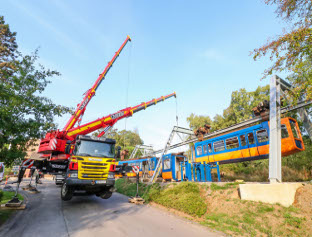Twin mobile cranes lift hanging trains
30 November 2018Crane and heavy logistics firm Neeb has used two Liebherr cranes to carefully remove hanging trains from Wuppertal’s suspension railway. The replacement of the trains, dating back to 1972, provoked local controversy, and many have been sold or raffled for re-use.
The suspension railway’s trains had been in use since 1972, as noted by their name GTW 72, which stands for “GelenkTriebWagen Baujahr 1972” (articulated railway cars built in 1972). Whilst four of the original 28 trains were taken out of service prematurely, the 24 other trains remained in use until 2016. Since then, the trains have been steadily removed and replaced by the new generation GTW 15.
Each type GTW 72 train consists of two end cars and a short centre section, and can accommodate 48 passengers in seats with a further 156 standing. The maximum speed of the suspended railway is actually 60km/h, but this is rarely achieved on the 13.3km track, which has 20 stops. The route of the track includes around 10km over the River Wupper and 3km over land. Each year, the railway, which is protected by a preservation order, is used by around 25 million passengers.
With the old carriages in much demand locally, and their potential scrapping fiercely resisted, Neeb was tasked with their careful removal. The final tandem lift took place recently. The train, which otherwise had only been hoisted using gantry trains in the suspension railway workshop, was removed from the system for the last time, placed on a low loader and suspended on a specially constructed frame by the two LTF 1060-4.1 cranes.
After the announcement that the GTW 72 trains were to be replaced, there was a great deal of controversy about the various trains, which meant that scrapping them was out of the question. Instead, 21 trains were sold and three trains were raffled in the form of a competition. The terms for all buyers were as follows: The buyer was responsible for transporting and installing the trains and had to provide a foundation with the appropriate load capacity. If the train was mounted on the ground rather than suspended, the full drive motor system and the bogies had to be removed, since otherwise the wagon bodies would be unable to withstand the pressure exerted by them.
The two LTF 1060-4.1 cranes hoisted a train off of a low loader and placed it on a frame specially built by Wuppertal company Knipex. The main job of the two telescopic cranes, each with a maximum lifting capacity of 60t, was to position the train in its final resting place undamaged and safe, as both the buyer and fans were anxiously looking forward to seeing it there. The last train to be replaced will be the centre of an event location for Knipex employees and visitors. In this case, it could also be mounted in full since it will be suspended rather than mounted on foundations.
Many of the trains have remained in Wuppertal—this was also one of the conditions for purchasing a train. The majority of the trains have been placed on foundations and some of them have undergone restoration. One train is currently being converted into a bistro. But some of the other trains have also been given new, unconventional roles – from playground equipment and use as a stand at the edge of a football pitch to an event location.
